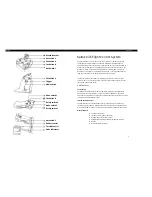
© National Instruments
|
4-5
Routing DI Start Trigger to an Output Terminal
You can route DI Start Trigger to any output PFI terminal. The output is an active high pulse.
DI Reference Trigger Signal
Use a reference trigger (di/ReferenceTrigger) signal to stop a measurement acquisition. To use
a reference trigger, specify a buffer of finite size and a number of pretrigger samples (samples
that occur before the reference trigger). The number of posttrigger samples (samples that occur
after the reference trigger) desired is the buffer size minus the number of pretrigger samples.
Once the acquisition begins, the cDAQ controller writes samples to the buffer. After the cDAQ
controller captures the specified number of pretrigger samples, the controller begins to look for
the reference trigger condition. If the reference trigger condition occurs before the cDAQ
controller captures the specified number of pretrigger samples, the controller ignores the
condition.
If the buffer becomes full, the cDAQ controller continuously discards the oldest samples in the
buffer to make space for the next sample. This data can be accessed (with some limitations)
before the cDAQ controller discards it. Refer to the KnowledgeBase document,
Can a
Pretriggered Acquisition be Continuous?
, for more information. To access this KnowledgeBase,
go to
and enter the Info Code
rdcanq
.
When the reference trigger occurs, the cDAQ controller continues to write samples to the buffer
until the buffer contains the number of posttrigger samples desired. Figure 4-2 shows the final
buffer.
Figure 4-2.
Reference Trigger Final Buffer
Using a Digital Source
To use DI Reference Trigger with a digital source, specify a source and a rising or falling edge.
Either PFI or one of several internal signals on the cDAQ controller can provide the source.
Refer to the
Device Routing in MAX
topic in the
NI-DAQmx Help
or the
LabVIEW Help
for more
information.
Using an Analog Source
Some C Series modules can generate a trigger based on an analog signal. In NI-DAQmx, this is
called the Analog Comparison Event.
Reference Trigger
Pretrigger
Sa
mple
s
Complete B
u
ffer
Po
s
ttrigger
Sa
mple
s















































